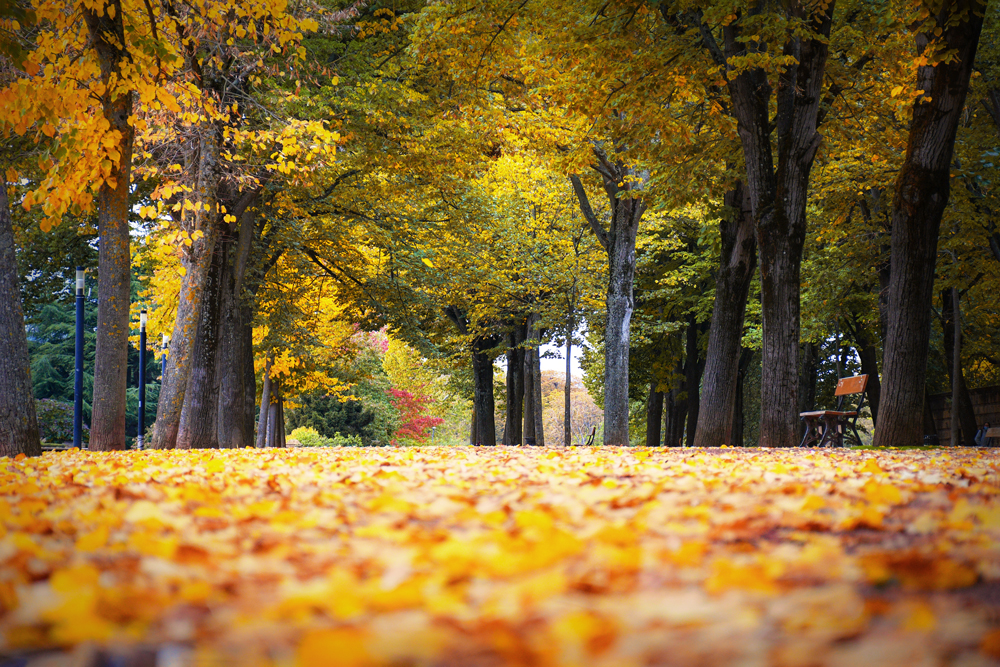Les Feuilles Mortes… The sight of a colourful autumn scene in a forest reminds us of a popular French song written in the aftermath of WW2. “Les Feuilles Mortes” (Autumn Leaves in English) has this nostalgic touch attached to it and fits perfectly for the autumnal season when summer is long gone and the prospect of a cold winter is ahead.
About the song “Autumn Leaves”
Les Feuilles Mortes (literally “The Dead Leaves”) is a popular French song originally recorded in 1945. It is known in English as “Autumn Leaves”.
The song was composed by Joseph Kosma with lyrics by French poet Jacques Prévert. It was featured for the first time in the movie “Les Portes de la Nuit” (1946) starring Yves Montand. However, the song was first recorded by Cora Vaucaire before the release of the film.
The English version of “Les Feuilles Mortes” was written by American songwriter Johnny Mercer in 1947 under the title “Autumn Leaves“. The song was introduced in America by Jo Stafford.
On Christmas’ Eve 1950, Édith Piaf sang the French and the English version of the song on the radio programme The Big Show.
It gives its name to a Hollywood movie in 1956 starring Joan Crawford. Nat King Cole sang “Autumn Leaves” in the title sequence of the film.
Many other singers have released a version of the song either in French or in English: Richard Anthony, Andrea Bocelli, Eric Clapton, Dalida, Serge Gainsbourg, Juliette Gréco, Patricia Kaas, Tino Rossi, Frank Sinatra, Barbra Streisand, Susan Boyle, Cora Vaucaire, Andy Williams.
The lyrics of the song
The song “Les Feuilles Mortes” is a poignant reflection on love, loss, and the passage of time. This classic French chanson, infused with melancholy and nostalgia, explores the fleeting nature of relationships and the enduring impact of memories.
The song begins with a yearning for the listener to remember happier days when they shared a close friendship when life seemed brighter and more vibrant. This wistful recollection sets the tone for the entire piece, emphasizing how past happiness contrasts sharply with the present.
The repeated image of “les feuilles mortes” (the dead leaves) is a powerful metaphor for the decay and decline that comes with the changing seasons, paralleling the changes in human relationships. The leaves, like memories and regrets, are gathered up, only to be swept away by the cold northern winds into the “cold night of oblivion,” symbolizing how memories can fade into the background of our minds.
The chorus
The chorus, “C’est une chanson qui nous ressemble” (This is a song that resembles us), suggests that the song itself mirrors the relationship between the singer and the listener—once full of love and mutual affection, now part of a past that is both cherished and mourned. The lyrics poignantly acknowledge how life quietly separates lovers, just as silently as the sea erases the footprints of separated lovers on the sand.
Despite the separation and the passage of time, the narrator’s love remains “silent and faithful,” a love that continues to smile and be grateful for the past they shared. Despite the pain of separation, this enduring affection shows deep gratitude for the moments once shared, underscoring the complex emotions of cherishing what once was while acknowledging that it is no more.
The song’s lament is deepened by the acknowledgement that the singer can never forget his beloved, who was once so beautiful and dear to him. He is haunted by the song she used to sing, a melody that continues to echo in his mind, forever linked to the memory of their love.
An evocation of fondness and sorrow
Overall, “Les Feuilles Mortes” encapsulates a universal experience of remembering a lost love with both fondness and sorrow. It portrays how memories, like autumn leaves, can be vivid and beautiful yet inevitably fade and transform as time passes. The song is a personal expression of loss and a reflection on the inevitability of change, resonating deeply with anyone who has ever loved and lost.
Read the French lyrics of the song here.






A beautiful if melancholy song.
Please also consider the exquisite recording in French by Joan Baez on the 1967 album “Joan”
Where is the back story on how it came to be written. Said to be of a Jewish couple; one did not make it due to the war, at the hands of the Nazis. The lyrics are the autumn rembrance of that lost love.
Thank you for adding this piece of information for the song’s history! 🙂
I had read that the composers had offered the song to Marlene Dietrich to record. She was in France after the war making a film with Jean Gabin. Gabin liked the song. But for whatever reason, Dietrich declined to record it. Pitty. Dietrichs film was a flop and he song became a standard.
Thank you Robert for letting us know about this, this is a very interesting contribution ! 🙂
There are many great versions of this song…Nat King Cole, Sinatra, Tony Bennett, Edit Piaf, Matt Monro…but my favorite version is by Doris Day…perfection.